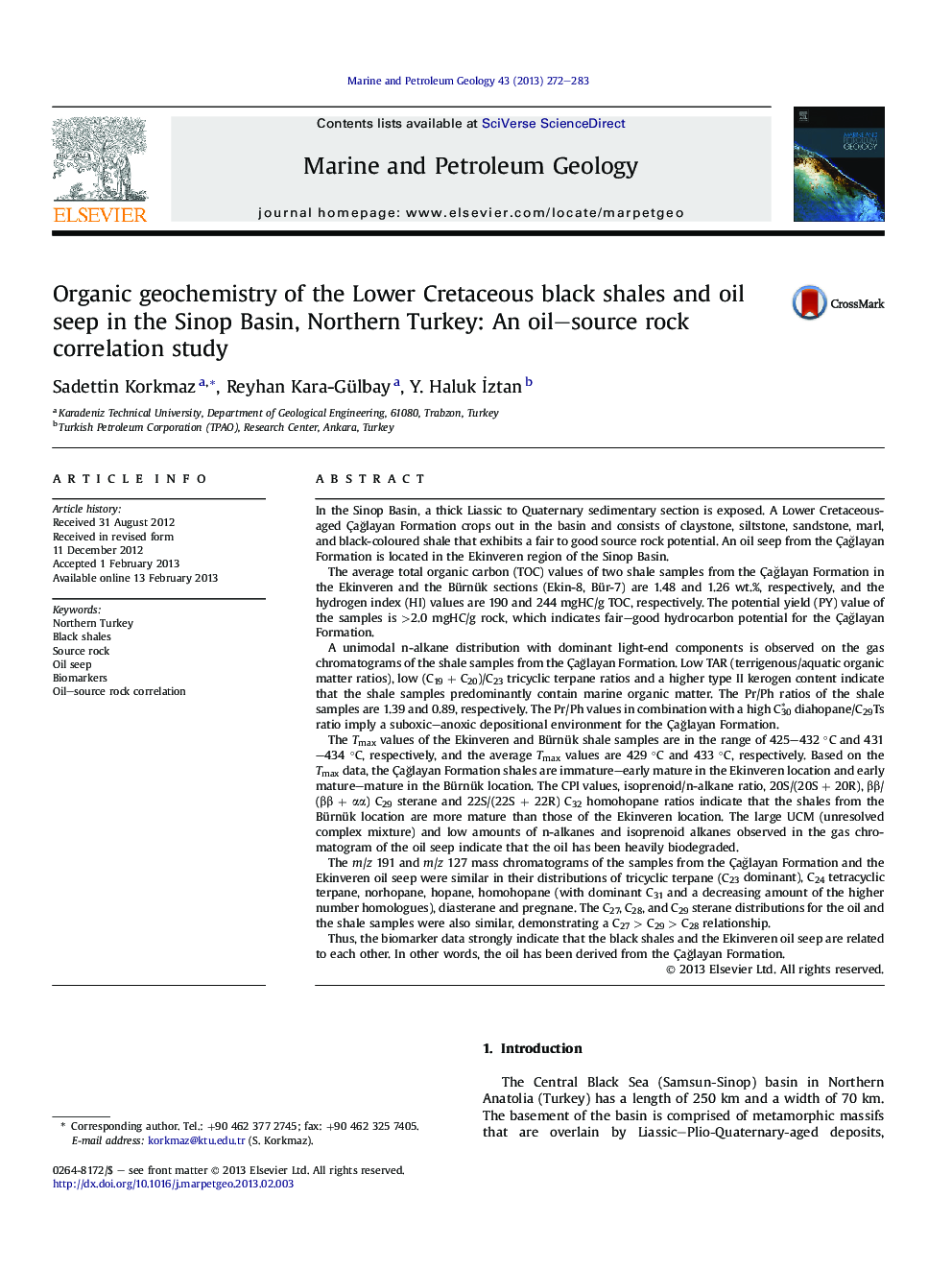| کد مقاله | کد نشریه | سال انتشار | مقاله انگلیسی | نسخه تمام متن |
|---|---|---|---|---|
| 6435536 | 1637181 | 2013 | 12 صفحه PDF | دانلود رایگان |

In the Sinop Basin, a thick Liassic to Quaternary sedimentary section is exposed. A Lower Cretaceous-aged ÃaÄlayan Formation crops out in the basin and consists of claystone, siltstone, sandstone, marl, and black-coloured shale that exhibits a fair to good source rock potential. An oil seep from the ÃaÄlayan Formation is located in the Ekinveren region of the Sinop Basin.The average total organic carbon (TOC) values of two shale samples from the ÃaÄlayan Formation in the Ekinveren and the Bürnük sections (Ekin-8, Bür-7) are 1.48 and 1.26 wt.%, respectively, and the hydrogen index (HI) values are 190 and 244 mgHC/g TOC, respectively. The potential yield (PY) value of the samples is >2.0 mgHC/g rock, which indicates fair-good hydrocarbon potential for the ÃaÄlayan Formation.A unimodal n-alkane distribution with dominant light-end components is observed on the gas chromatograms of the shale samples from the ÃaÄlayan Formation. Low TAR (terrigenous/aquatic organic matter ratios), low (C19 + C20)/C23 tricyclic terpane ratios and a higher type II kerogen content indicate that the shale samples predominantly contain marine organic matter. The Pr/Ph ratios of the shale samples are 1.39 and 0.89, respectively. The Pr/Ph values in combination with a high C30â diahopane/C29Ts ratio imply a suboxic-anoxic depositional environment for the ÃaÄlayan Formation.The Tmax values of the Ekinveren and Bürnük shale samples are in the range of 425-432 °C and 431-434 °C, respectively, and the average Tmax values are 429 °C and 433 °C, respectively. Based on the Tmax data, the ÃaÄlayan Formation shales are immature-early mature in the Ekinveren location and early mature-mature in the Bürnük location. The CPI values, isoprenoid/n-alkane ratio, 20S/(20S + 20R), ββ/(ββ + αα) C29 sterane and 22S/(22S + 22R) C32 homohopane ratios indicate that the shales from the Bürnük location are more mature than those of the Ekinveren location. The large UCM (unresolved complex mixture) and low amounts of n-alkanes and isoprenoid alkanes observed in the gas chromatogram of the oil seep indicate that the oil has been heavily biodegraded.The m/z 191 and m/z 127 mass chromatograms of the samples from the ÃaÄlayan Formation and the Ekinveren oil seep were similar in their distributions of tricyclic terpane (C23 dominant), C24 tetracyclic terpane, norhopane, hopane, homohopane (with dominant C31 and a decreasing amount of the higher number homologues), diasterane and pregnane. The C27, C28, and C29 sterane distributions for the oil and the shale samples were also similar, demonstrating a C27 > C29 > C28 relationship.Thus, the biomarker data strongly indicate that the black shales and the Ekinveren oil seep are related to each other. In other words, the oil has been derived from the ÃaÄlayan Formation.
⺠Sinop Basin consists of thick sedimentary section from Liassic to Quaternary. ⺠An oil seep is located in Ekinveren region of the Sinop Basin. âºÂ Black shales from ÃaÄlayan Formation have source rock characteristic. ⺠Organic geochemistry characteristics of the black shales and oil seep are similar. ⺠The data show that oil has been derived from black shales in the ÃaÄlayan Formation.
Journal: Marine and Petroleum Geology - Volume 43, May 2013, Pages 272-283